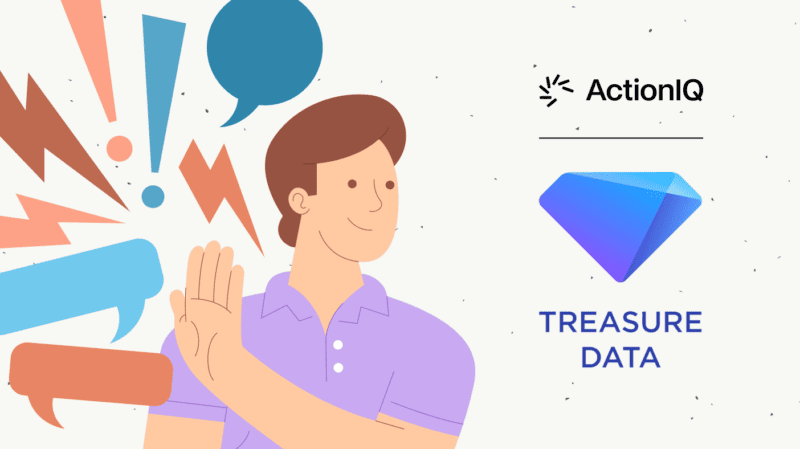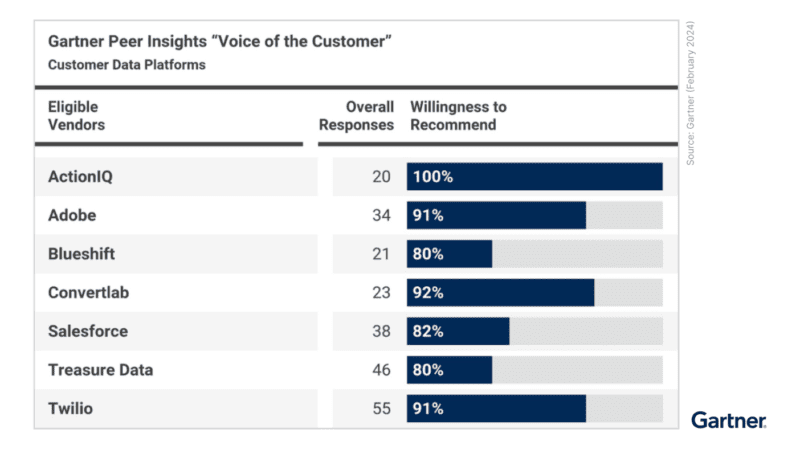What is the Treasure Data CDP?

The customer data platform (CDP) market is confusing — but it doesn’t have to be. This post on “What is the Treasure Data CDP?” is part 5 in a series of blog posts exploring different types of CDPs, how they differ from other technologies and what you can do to select the right vendor for your enterprise company. Check out part 1 on the Adobe Marketing Cloud CDP, part 2 on the Salesforce Marketing Cloud CDP, part 3 on the Segment CDP and part 4 on the Amperity CDP.
Treasure Data — which was born after the brand pivoted away from its struggling business model into the CDP market — is a prime example of a data science CDP.
Like other data science CDPs, such as Acquia and SAS, Treasure Data was built for predictive modeling and advanced analytics.
But as with data integration CDPs and identity management CDPs, enterprise brands must ask themselves if the limitations inherent in this technology will serve their needs across a wide range of business use cases. We’ll help you determine whether the Treasure Data CDP will suit your needs.
Who is the Treasure Data CDP for?
Treasure Data was designed for analytics professionals. These data scientists, who often reside on IT teams, are tasked with extracting insights from customer data and measuring marketing performance.
Because the Treasure Data customer data platform requires significant scripting and coding, analysts often describe it as developer-focused. Some feel it’s hard to manage and geared toward more experienced users.
Further demonstrating how it’s designed for technical professionals instead of everyday business users, Treasure Data does not include a visual user interface for creating marketing campaigns. This is because its capabilities end with segments of customers that are sent to separate campaign management and journey orchestration tools that business users rely on.
The appeal of the Treasure Data CDP is in its pre-packaged analytical models. But reliance on prebuilt, black-box models rarely appeals to enterprise brands seeking higher predictive power from models customized for their unique business needs.
For this reason, Treasure Data generally appeals most to mid-market organizations where data science teams don’t have enough bandwidth to create their own models. But we wouldn’t recommend it to marketers or other less technical users.
How Do You Use the Treasure Data Customer Data Platform?
With APIs for ingesting data — as well as technical interfaces for configuring models and audience segmentation — Treasure Data is used by analytics teams to generate predictive insights related to customer lifetime value (CLTV), customer churn and more.
It comes with pre-packaged models, which help speed up the production of such insights. But be aware that pre-configured models tend to have lower predictive power, compromising the impact of data modeling on customer experience and strategy optimization.
What Are the Pros & Cons of the Treasure Data CDP?
Thanks to prebuilt integrations with numerous digital data sources — as well as many configurable analytic models — Treasure Data is a solid solution for organizations that need to get their predictive analytics programs off the ground.
Additionally, Treasure Data’s real-time ingestion and response capabilities, along with its self-service tools for developers, provide brands’ technical teams with substantial flexibility.
That said, enterprise companies hoping to empower their business teams will be left wanting.
The Treasure Data customer data platform began as a big data managed services company, positioning itself as a Hadoop-based data warehouse in the cloud. This heritage means it’s geared toward developers and technical professionals, not marketing, sales or customer service teams.
While self-service scenarios among business teams are possible, users must ship data to business-focused tools, resulting in time and resources spent on managing additional data feeds and data layers, not to mention increasing opportunities for data loss and out-of-sync systems.
Because the Treasure Data CDP will make business teams dependent on technical assistance, brands are likely to struggle with operational bottlenecks, longer time to value and missed market opportunities, as well as costs related to IT and data teams responding to ad hoc requests instead of focusing on higher-value projects.
How Does ActionIQ Compare?
Like the Treasure Data CDP, ActionIQ provides brands with a library of predictive models. But unlike Treasure Data, ActionIQ’s models can be fully customized to each brand’s business, delivering substantially higher performance.
Additionally, ActionIQ has a business-friendly no-code interface to define and analyze customer segments and a visually intuitive drag-and-drop dashboard that empowers business users to analyze customer behaviors, visualize trends and identify anomalies.
ActionIQ also enables business teams to take action on customer insights via a journey orchestration tool that supports unlimited steps and decision branches across all online and offline channels, ensuring maximum sophistication and flexibility.
And thanks to our proprietary HybridCompute data infrastructure — which features unlimited computation power from on-demand auto-scaling — brands are able to leverage data across infinite teams and departments without ever experiencing wait times or bottlenecks. This makes data instantly available for on-demand insights and iteration. Data science CDPs such as Treasure Data often experience challenges with scale, hampering agility and slowing down speed to market.
ActionIQ also enables brands to deduplicate customer records via our machine learning-powered PersonMatch capability. This is becoming an even more important CDP capability in the face of third-party cookie deprecation, but the Treasure Data customer data platform relies on standard exact-match profile matching, meaning enterprise brands with numerous customer-facing channels — including websites, call centers, brick-and-mortar, etc. — will likely struggle with duplicate customer records.
Since ActionIQ has been built from the ground up with business-friendly access in mind, brands can significantly reduce dependence on IT and data teams. This drives a 25% gain in marketing efficiency as well as a 40% reduction in data analyst workload. Combined with cost savings and increases in revenue, brands can expect a return on investment of 522% when working with ActionIQ.
Stay tuned for part 6 in this blog series, where we’ll explore the BlueConic CDP.
Learn More About Choosing the Right CDP for Your Needs
Download our CDP Market Guide to learn more about different types of CDPs or contact one of our experts to see how ActionIQ differs from Treasure Data and other data science CDPs.





